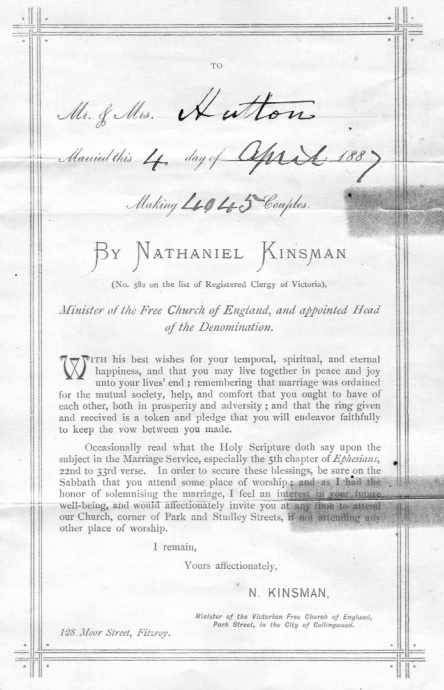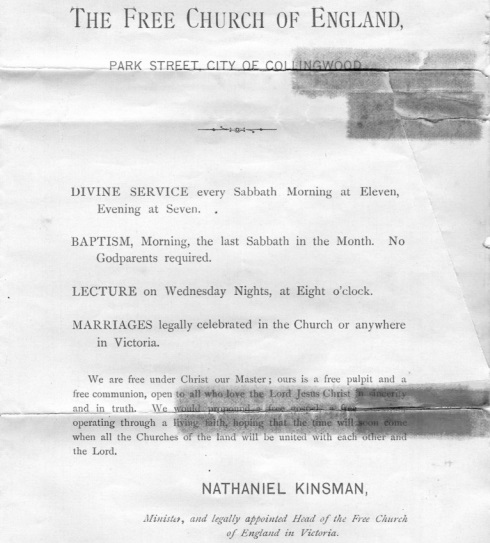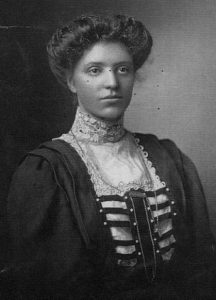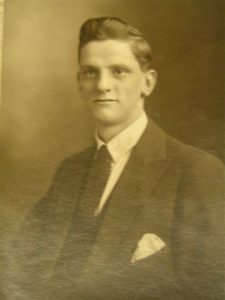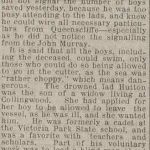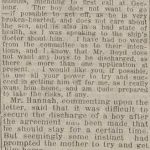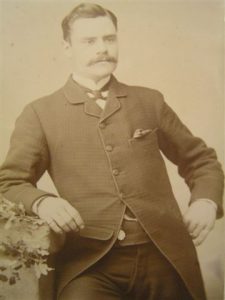
Alfred Hutton
Alfred Hutton was born on 17 November 1862 at 16 Rupert Street, Collingwood to parents Charles Benjamin Hutton (1817-1873) and Eliza McSweeney (1819-1885).
His father Charles was a home/house agent born in Exeter in Devonshire, England, and his mother was from Cork in Ireland.
Alfred was the last child of seven children born to the couple.
He was baptised at St Peters, Eastern Hill, Melbourne on 6 June 1862, his home residence given as East Collingwood.
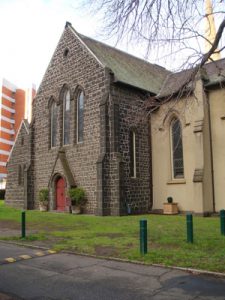
St Peters Eastern Hill Melbourne
St Peter’s, Eastern Hill (15 Gisborne Street) is the Anglican parish church of the City of Melbourne, Victoria, Australia.
The parish church dates from 1847. The letters patent of Queen Victoria declaring the city status of Melbourne were read on the steps of St Peter’s in 1848.
Sadly Alfred’s father died of phthisis (tuberculosis) after suffering with it for a year, when he was just 10 years of age in 1873. The family were then living at 18 Dorset Street in Collingwood.
His mother Eliza Hutton was left to raise six boys on her own. His oldest brother William had died aged 10 in 1858 four years before Alfred was born.
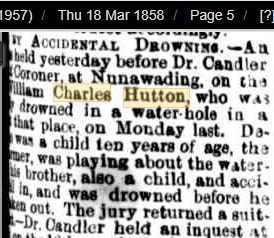
William Charles Hutton drowned aged 10 1858
William had accidentally drowned when the children were playing together in a fenced off 14 foot round waterhole in their fathers farm paddock at Nunawading.
His brother Pierce gave a statement at the coroners inquest in which he saw his brother lose his footing and slip under the water.
After the death of his father the family moved to 18 Dorset Street, Collingwood in 1874.
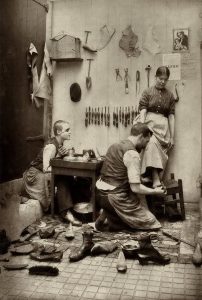
a bootmaker’s shop
They appear in the rates books living in house there for many years. The street has since been demolished and rebuilt with brick factories.
Alfred was a bootmaker living and working in Collingwood. In 1880 he appeared in the Carlton Petty Sessions Court putting in a complaint about wages against William Millson, but the dispute was settled privately.
In 1887 Alfred Hutton, bootmaker, appears in the rate books in Forest Street, Collingwood (west side) renting a brick house and land from Mr Henry Young.
On 4 April 1887 Alfred Hutton married Asenath Clara Jennings at the Free Church of England, Park Street in Collingwood.
- Free church certificate
- Free Church of England Collingwood leaflet
Asenath Clara Jennings was born illegitimately on 28 August 1863 in the Melbourne Lying In Hospital in North Melbourne to parents Asenath Hall Jennings (1835-1912) and George Cranston Robson (1843-1894). Her father is confirmed by DNA.
Asenath’s paternal grandfathers family, the Barnicoats, owned land in St Levan, Cornwall and appear on the Tithe Maps in 1838 (Christopher Barnicoat 1781-1862).
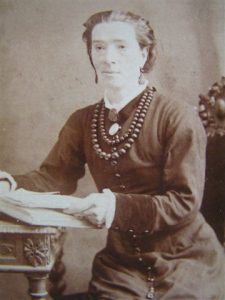
Asenath Clara Hutton nee Jennings / Robson
Asenath was baptised on 10 August 1868, aged 4, at St Lukes, Yea, Victoria.
The baptism register states she is the illegitimate daughter of George Robson, labourer of Upper Plenty and Asenath Hall Jennings.
Asenath was one of four known children of her mother, but all but one sister Mary Jane Jennings (1870-1953) survived childhood.
Alfred and his wife Asenath, known by her second name of Clara – had six children –
- 1888 Eliza A b Collingwood d 1965 Numurkah, married Ernest Mills
- 1890 Alfred C W B b Collingwood d 1953 Fitzroy, married Ruby Page
- 1893 William A V b Collingwood d 1958 Merylnston, married Martha Doris Bridges
- 1896 Ernest E C b Collingwood d 1911 Melbourne East, drowned aged 15
- 1899 Edith C b Collingwood d 1950 Northcote, married George Patterson
- 1902 Harold C b Collingwood d 1972 Kingsbury married Clarice Willmott
- Eliza Mills nee Hutton
- Harold Christian Hutton
From 1892 in the Sands and McDougall Melbourne Directory Alfred is living at 29 Bendigo Street, Collingwood.
Alfred died on 29 November 1903 at 29 Bendigo Street, Collingwood. He is buried in the General Melbourne Cemetery with no headstone in the Church of England section, GG 2004.

Alfred Hutton newspaper death notice 1903
In his probate he leaves the house at Bendigo Street, to his wife Asenath and six children.
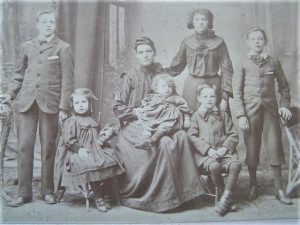
LtoR Hutton family at Alfred’s death in 1903 inc Alfred 13 Clara 4 Eliza 15 baby Harold 1 Asenath 40 Ernest 7 and William 10
After the loss of her husband in 1903 Asenath Clara was in quite desperate circumstances. Her boys were in and out of the petty sessions courts for minor offences. Perhaps because of this in 1911 her son Ernest was placed aboard the ‘John Murray Training Ship’ with tragic consequences.
The Victorian Government commissioned the ‘John Murray Training Ship’ for formative training purposes for juvenile offenders from 1910 until 1918. It aimed to train seamen for the navy and merchant navy. It ceased operations in controversial circumstances in 1918.
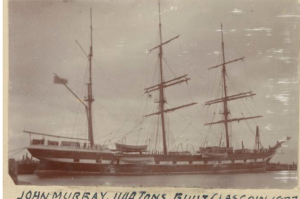
“John Murray” training ship
Between the commissioning and abandonment of the enterprise, 411 boys passed through the ship. The John Murray was dogged by misadventure and controversy. Allegations of ‘unnatural practices’ brought an odium on the ship which a Police Magistrate’s inquiry in 1911 and a royal commission in 1915 were not able to dispel entirely.
What was meant to be an institution for the formative training of juvenile offenders soon became a political and financial embarrassment. Established to train seamen for the navy and the merchant service, discipline was harsh and desertion rife. Fewer than one boy in five completed his training and joined other ships.
It seems Clara was trying to have her son removed from the ship, as he was ill, and wanted to leave, and she had even written to her local parliamentary member to engage his help to do so just days before he drowned. The ship hit the bay steamer the “Hygeia” near the Port Melbourne Railway Pier, and capsized, throwing 8 boys into the water on December 11. All the boys were saved except Ernest, who couldn’t be found in the choppy sea conditions until the following day.
Click on the pictures below to read more.
- The Argus 11 Dec 1911
- Bendigo Independent 1911 pg1
- Bendigo Independent 1911 pg2
An inquest was conducted into the tragedy starting on 29th December 1911. The inquest went for several days and finally Captain Maitland of the Hygeia was found guilty of manslaughter of Ernest Hutton on Monday 8th January 1912, and committed for trial. He was master in charge of the Hygeia and it was due to his negligence the accident occurred. Witnesses at the trial (night watchman at the Sailors Home) testified the captain was very drunk the night before, and was still seedy at 7am the next morning.
On February 2, the case went to court, and the Crown prosecutor announced to Judge Eagleson that no presentment had been filed by the Crown, so the case was removed from the days proceedings. The captain was therefore acquitted. I can’t imagine the grief of the family.
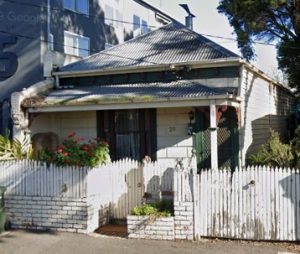
29 Bendigo Street Collingwood home of Alfred and Asenath Clara Hutton 1892-1927
Asenath Clara continued to live at 39 Bendigo Street, Collingwood until her death with her unmarried daughter Edith.
She died on 7 December 1927 aged 61 of a brain haemorrhage.
She was buried in the General Melbourne Cemetery with her husband, listed under ‘Clara Hutton’ and has no headstone.
Daughter Edith was finally free to marry, aged 29, which she did in 1929 to George Patterson.
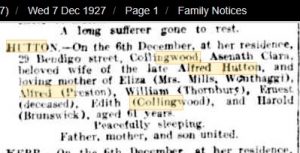
Asenath Clara Hutton death notice The Argus 1927

